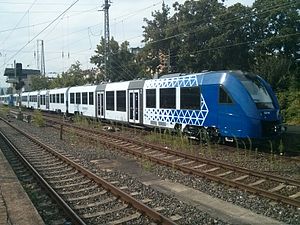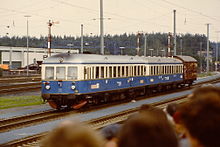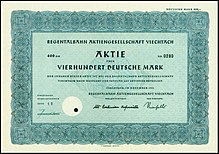Regentalbahn
| Regentalbahn AG | |
|---|---|
|
|
|
| Basic information | |
| Company headquarters | Viechtach |
| Web presence | www.laenderbahn.com |
| Reference year | 2013 |
| owner | Netinera |
| Managing directors | Wolfgang Pollety |
| Employee | 680 |
| sales | 140 |
| number of vehicles | |
| Railcar | 88 |
| statistics | |
| Passengers | 10 million |
| Mileage | 12 million train kilometers |


The Regentalbahn AG ( RAG ) was founded on May 9, 1889 as AG Lokalbahn Gotteszell – Viechtach and operates railway infrastructure as well as regional passenger and long-distance rail transport in Bavaria and Saxony with connections to the Czech Republic . It is also involved in rail freight transport across Germany .
The company is based in Viechtach in Lower Bavaria and has been part of the Italian Ferrovie dello Stato via its parent company Netinera since 2011 . Between 2004 and 2010, Netinera was part of the Europe-wide transport group Arriva under the name Arriva Germany . Due to antitrust requirements, Deutsche Bahn , which Arriva took over on August 27, 2010, had to sell the German parts of this company.
Since December 2015, the Regentalbahn subsidiaries have been operating under the umbrella of Länderbahn GmbH DLB , a 100% subsidiary of Regentalbahn.
Creation of the Regentalbahn
On May 9, 1889, on the basis of the "concession to manufacture and operate a standard-gauge local railway from Gotteszell to Viechtach" of April 28, 1889, the local railway company Gotteszell-Viechtach was brought into being.
From November 10, 1890, freight trains ran from Gotteszell to Teisnach, and on November 20, 1890, all traffic on this railway line to Viechtach was opened. In 1903 the company acquired the "Granitwerke Teisnach AG" with the Prünst quarry, which to this day supplies gravel for road construction.
In 1924/25 the construction of the new line from Viechtach to Blaibach was tackled, on which goods traffic was opened on January 2, 1928 and passenger traffic on February 1, 1928. This completed the Gotteszell – Blaibach railway line , which as such is also known as the “Regentalbahn”.
On January 1, 1928, the " Lokalbahn Deggendorf – Metten AG " was added, which merged with the local railway Gotteszell – Viechtach now called "Regentalbahn AG".
On January 1, 1973, Regentalbahn AG also took over the “ AG Lokalbahn Lam – Kötzting ”, also over eighty years old , for which it had been operating since 1967.
In 2002, the brand name Die Länderbahn was established for RAG , which is intended to make it clear that the railway company is active in Bavaria , Saxony , Thuringia and the Czech Republic . At the same time, the corporate image and its subsidiaries were structured and redesigned. The branding and corporate design were developed by the design agencies Tricon AG and Intention AG.
The Regentalbahn is a member of the tariff association of federal and non-federal railways in Germany (TBNE).
Subsidiaries
Since the 1970s, the time has been characterized by modernization and rationalization measures, a large number of railcars were purchased (initially used, since the 1980s also new) and various corporate divisions were spun off into subsidiaries.
In 1980, the Prünst granite factory was incorporated into a GmbH in which the Regentalbahn held a 50% stake. This participation was sold in 2005.
In addition, the following 100% subsidiaries were created under the umbrella of the Regentalbahn:
- 1979-2004 Regental Kraftverkehrs GmbH (RKG)
- 1988–2015 the Regental Bahnbetriebs-GmbH (RBG)
- 1989–2015 Regental Fahrzeugwerkstätten GmbH (RFG)
- 1998 Vogtlandbahn GmbH (VBG) (since December 2015: Die Länderbahn GmbH DLB )
- 2012 the vlexx GmbH
From 1993 to December 2013 the Regental Bahnbetriebs-GmbH operated all routes of the Zwieseler Spider : Plattling – Bayerisch Eisenstein , Zwiesel – Grafenau and Zwiesel – Bodenmais on behalf of Deutsche Bahn (DB Regio Bayern) under the brand name Waldbahn . On their behalf, it has not only operated its own Bad Kötzting - Lam route since 2001 under the brand name Oberpfalzbahn , but also the Schwandorf - Cham - Furth im Wald, Cham - Waldmünchen and Cham - Bad Kötzting routes. In addition, Regental Bahnbetriebs-GmbH owned the Regental Cargo freight transport division , which drove freight trains across Germany. It had its operating center in Neuenmarkt-Wirsberg (with a branch in Zwickau ) and was integrated into the Eccocargo freight wagon network. The Länderbahn has been operating the Zwieseler Spinne since December 2013 and the Upper Palatinate Railway since December 2014 . At the start of operations in December 2013, a small workshop was built in Zwiesel to service the vehicles used.
The Vogtlandbahn , founded on January 1st, 1998, took over the transport services transferred to the RBG in Saxony. From 2005 to 2012 it offered the Vogtland-Express as an independent long-distance train , which connected the Vogtland with Berlin once a day .
In December 2003, the Allgäu-Express ( alex ) between Munich and Oberstdorf was started as a replacement service for the discontinued Interregio line 25 in cooperation with EuroThurbo GmbH (since the beginning of 2005 SBB GmbH ) . After the Regentalbahn won the tender for the next, longer tendering period in December 2005, since the timetable change in December 2007 it has been responsible for long-distance traffic not only on the route from Munich to Oberstdorf, now with a train to Lindau , but also for the Routes Munich - Regensburg - Hof and Munich - Regensburg - Furth im Wald - Prague. The alex brand was retained, but was now interpreted as Arriva-Länderbahn-Express ; the traffic is handled by the Vogtlandbahn. Since 2010 it has only been referred to as alex , the name Arriva-Länderbahn-Express was dropped. The brand and vehicle design, like the corporate design, was developed by the Tricon and Intention agencies.
On January 1, 2004, the Regentalbahn sold its subsidiary Regental Kraftverkehrs GmbH to Regionalbus Ostbayern GmbH for economic reasons . The bus company took over the vehicles and employees and continues to operate the bus routes from Viechtach and Lam.
The Regental garages operates workshops for all tracks of the state railway: One at the headquarters Viechtach in the Bavarian Forest, another in Neumark in Vogtland and in Schwandorf. It was rebuilt on the route to Furth im Wald and inaugurated on December 22, 2007. This is where the Oberpfalzbahn's shuttle railcars and the Alex locomotives and cars are serviced. Another smaller workshop was built in Zwiesel. In order to carry out easier maintenance, a double-track 35 m long and 15.5 m wide hall including a social wing was built there at the operating center of the forest railway. The workshop was opened in December 2013.
In October of the same year, the Berchtesgadener Land Bahn , a consortium of the Regentalbahn and Salzburg AG , emerged as the winner from the tender for regional rail services on the Freilassing – Berchtesgaden railway line , which took over the traffic when the timetable changed in December 2009 Has.
The Regentalbahn today includes the following corporate parts and brands via Die Länderbahn (DLB) :
- alex (since 2003)
- Berchtesgadener LandBahn (joint subsidiary with Salzburg AG )
- Upper Palatinate Railway (since 2001)
- Regental Cargo (freight transport)
- Rainwater works
- Trilex (since 2009)
- Vogtland Railway
- Waldbahn (since 1996)
In addition, vlexx GmbH is an independent subsidiary of Regentalbahn.
Ownership
For a long time, the shares in the Regentalbahn were divided among numerous owners. In 1940 these included the German Reich, the State of Bavaria, the Bavarian State Bank and the Deutsche Reichsbahn. By 1982 the Free State of Bavaria had acquired 76.9% of the shares. The rest was divided between cities and municipalities, the Benedictine abbey of Metten and private individuals. In autumn 2004, the Free State sold the majority of the shares to the pan-European British transport company Arriva . Its German subsidiary Arriva Deutschland increased its stake in Regentalbahn to 100 percent by May 2006 through further acquisitions. Arriva, for its part, was bought by Deutsche Bahn in 2010 . However, Arriva Deutschland had to sell this on for reasons of competition law. The contract was awarded in December 2010 to the Italian state railway Ferrovie dello Stato , which took over the company together with the French-Luxembourg financial investor Cube Infrastructure. The new owners renamed Arriva Germany to Netinera in March 2011 .
Railway infrastructure company
After the takeover of AG Lokalbahn Lam-Kötzting on January 1, 1973, the company's route network reached its greatest expansion at 61.7 km. After the closure of the Blaibach – Fichtental section on February 4, 1991 (8.9 km), the Deggendorf – Metten line on August 1, 1993 (4.2 km) and the Fichtental – Viechtach section on September 1, 1993 (6, 0 km), Regentalbahn AG still operates a 42.6 km route as a railway infrastructure company.
vehicles

The first locomotives were two-axle steam locomotives , locomotive ANNA is still preserved at the Bavarian Local Railway Association . The following, more powerful steam locomotives also had names. Between 1961 and 1980, the Regentalbahn operated the six-axle D 1 (later D 01) diesel locomotive, the only example of the DG 2000 CCE series (nickname "Hans the Great").
After the first attempts with railcars, a diesel railcar was delivered by the Dessauer Waggonfabrik in 1939 . This VT 01 vehicle has been preserved and can be viewed today (2019) in good condition in the Dessau Railcar Museum . The vehicle was painted red / beige on delivery.
In the 1950s and 1960s several Esslingen railcars were bought used. One of these railcars is in use in tourism. Two battery- powered railcars were converted into diesel-electric railcars in our own workshop . New (1981 and 1985) two NE 81s with matching control cars (1985) were purchased. All these railcars were blue with white ribbon windows. In the meantime, 25 Stadler Regio-Shuttle RS1 are in use, mostly in green and orange colors.
literature
- Andreas Fried, Klaus-Peter Quill: Regentalbahn . Bufe-Fachbuch-Verlag, Egglham 1999, ISBN 3-922138-72-1 .
- Gerd Wolff: German small and private railways - Volume 7: Bavaria . EK-Verlag, Freiburg 2002, ISBN 3-88255-666-8 .
- Tobias Richter (Regentalbahn AG): Perspectives for rail traffic in Eastern Bavaria from the Regentalbahn / Vogtlandbahn perspective , in: IHK Regensburg and Niederbayern (ed.): Rail traffic conference, perspectives for rail traffic in Eastern Bavaria, Weiden, July 11, 2006 (PDF, 2 , 6 Mbytes), pp. 15-19.
- Bernhard Rückschloß: The "Mettener Bockerl" - history of the disused local railway Deggendorf - Metten , Modell-Eisenbahn-Verein Deggendorf e. V. (editor), Deggendorf 1999, ISBN 3-934726-00-3 .
- Bernhard Rückschloß: The Deggendorf steam locomotive - draft horse on branch lines in the Bavarian Forest , Modell-Eisenbahn-Verein Deggendorf e. V. (editor), Deggendorf 2017, ISBN 978-3-934726-81-9 .
swell
- ↑ a b c d e Passauer Neue Presse: “Course set for further growth”, July 17, 2014
- ↑ a b Vehicle design - Upper Palatinate Railway. Tricon AG, accessed on July 16, 2013 .
- ↑ a b References - Customers - Regentalbahn. Intention AG, accessed on July 16, 2013 .
- ↑ Regensburg Busse.de: Regentalbusse , accessed on April 6, 2015
- ↑ Zwieseler Bayerwald-Bote: "Regentalbahn plans workshop in Zwiesel", December 26, 2012
- ↑ Zwieseler Bayerwald-Bote: "Regentalbahn is preparing to build a train workshop", July 3, 2013
- ↑ Deutzer single item in: Lok Magazin 6/2018, p. 90 f.


